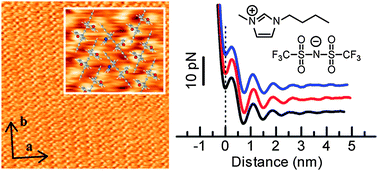Molecularly clean ionic liquid/rubrene single-crystal interfaces revealed by frequency modulation atomic force microscopy†
Abstract
The structural properties of ionic liquid/rubrene single-crystal interfaces were investigated using frequency modulation atomic force microscopy. The spontaneous dissolution of rubrene molecules into the ionic liquid was triggered by surface defects such as rubrene oxide defects, and the dissolution rate strongly depended on the initial conditions of the rubrene surface. Dissolution of the second rubrene layer was slower due to the lower defect density, leading to the formation of a clean interface irrespective of the initial conditions. Molecular-resolution images were easily obtained at the interface, and their corrugation patterns changed with the applied force. Force curve measurements revealed that a few solvation layers of ionic liquid molecules formed at the interface, and the force needed to penetrate the solvation layers was an order of magnitude smaller than typical ionic liquid/inorganic solid interfaces. These specific properties are discussed with respect to electric double-layer transistors based on the ionic liquid/rubrene single-crystal interface.


 Please wait while we load your content...
Please wait while we load your content...